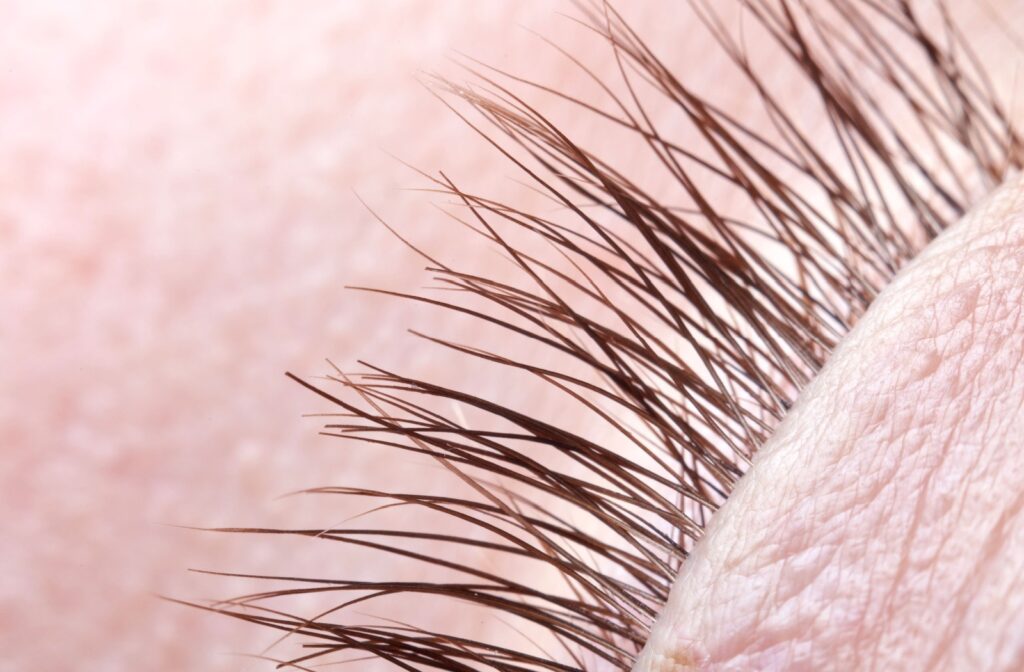You might be surprised to learn that we all have microscopic organisms living on our skin, including our eyelashes. These tiny mites are a normal part of the human microbiome and usually go unnoticed. However, when their numbers grow, they can contribute to uncomfortable eye irritation and symptoms of dry eye disease.
Understanding what causes them to multiply is the first step toward managing them. A combination of consistent at-home hygiene and professional treatments can effectively manage and reduce the lash mite population. This approach, often guided by an optometrist during a comprehensive eye exam, helps restore balance to your eyelids, leading to more comfortable and healthy eyes.
What Exactly Are Eyelash Mites?
You have microscopic mites living on your skin, and that’s completely normal. These tiny, eight-legged creatures, known as Demodex, live in or near hair follicles. They play a role in your skin’s natural ecosystem by consuming dead skin cells and oils.
Tiny Mites on Your Eyelashes
There are 2 main types of Demodex mites that live on your face. Demodex folliculorum lives in hair follicles, like your eyelashes, while Demodex brevis prefers the oil glands that line your eyelids.
The Short Life of a Lash Mite
The entire lifecycle of an eyelash mite is about 14–18 days. During this time, they hide in your lash follicles during the day. They come out at night to eat, mate, and lay eggs.
When Mites Become a Problem
Problems arise when the mite population grows too large. An overgrowth can block oil glands, carry bacteria, and lead to irritation, a condition that contributes to the causes of dry eye. This is more common as people age or in those with certain skin conditions.
Signs and Symptoms of a Mite Outbreak
An overgrowth of lash mites can cause noticeable symptoms. If your eyes feel constantly irritated, it might be more than just dryness. A local optometrist can help determine the cause of your discomfort.
How to Know If You Have Eyelash Mites
While you can’t see the mites without a microscope, you can look for specific signs. An eye doctor uses a special magnifying tool to spot tell-tale signs, such as dandruff-like debris at the base of the eyelashes.
Common Symptoms You Might Notice
- Scratchiness along the eyelid
- A burning or stinging sensation
- Red or swollen eyelids
- Crusty or sticky eyelashes, especially in the morning
- A feeling that something is in your eye
- Blurry vision that comes and goes
Connection to Other Skin and Eye Conditions
An excess of Demodex mites is often associated with conditions such as blepharitis, eyelid inflammation, and ocular rosacea. The mites can worsen the inflammation and irritation associated with these conditions.
Causes and Risk Factors for Lash Mites
Certain factors can contribute to an overgrowth of eyelash mites. Understanding these factors can help you manage the mite population on your eyelids and promote better eye health.
The Role of Personal Hygiene
Not cleaning your eyelids and face thoroughly can allow oil and dead skin cells to build up. This creates a perfect environment for mites to thrive. A consistent hygiene routine is important for keeping their numbers in check.
Age and Your Immune System
Mite populations tend to increase as you get older. A less robust immune system may have a harder time maintaining the balance of mites. As research shows, aging also increases dry eye risk, which can lead to the symptoms of irritation that many people experience.
Effective Ways to Manage Lash Mites

If you suspect an overgrowth of eyelash mites, there are several steps you can take to address the issue. These range from simple home care to professional treatments. The goal is to reduce the mite population and soothe irritation.
At-Home Care for Your Eyelids
Gentle, consistent cleaning is key. A daily routine of washing your eyelids with a mild cleanser or specific eyelid scrubs can help reduce the number of mites. Applying warm compresses can also help loosen debris and open clogged oil glands.
Professional Treatments for Mite Infestations
For more persistent cases, an eye doctor might recommend specific treatments. These can include medicated ointments or in-office procedures, such as eyelid exfoliation or intense pulsed light (IPL) therapy, designed to thoroughly clean the eyelids. This helps to reduce the mite population and manage symptoms.
When to Visit Your Optometrist
If home remedies don’t provide relief or your symptoms worsen, it’s time to see a professional. An optometrist can properly diagnose the issue. We can then recommend a treatment plan tailored to your dry eye or aesthetic concerns.
How to Prevent Future Lash Mite Problems
Once you have the mite population under control, a few simple habits can help prevent another overgrowth. These practices keep your eyes healthy and comfortable for the long term. A proactive approach is often very effective.
A Daily Eye Care Routine
Make eyelid hygiene part of your daily routine. Using a gentle, doctor-recommended cleanser, wash your eyelids each morning and night to remove buildup. Always remove all eye makeup before going to sleep to prevent clogged follicles that feed mites.
Makeup, Mascara, and Mites
Mites can be transferred through shared cosmetics. Avoid sharing mascara, eyeliner, or makeup brushes with others. It’s also a good practice to replace your eye makeup, especially mascara, every 3 months.
Keep Your Bedding and Towels Clean
Mites can live in pillows and sheets, so good household hygiene is helpful. Wash your bedding and towels regularly in hot water. Dry them on high heat to help eliminate any mites or eggs.
Say Goodbye to Irritation
At Luminance Vision, we believe clear and comfortable vision is an essential part of your well-being. If you’re experiencing persistent eye irritation or are concerned about your eyelid health, we are here to help. Schedule a consultation with us today to explore our dry eye treatments.




